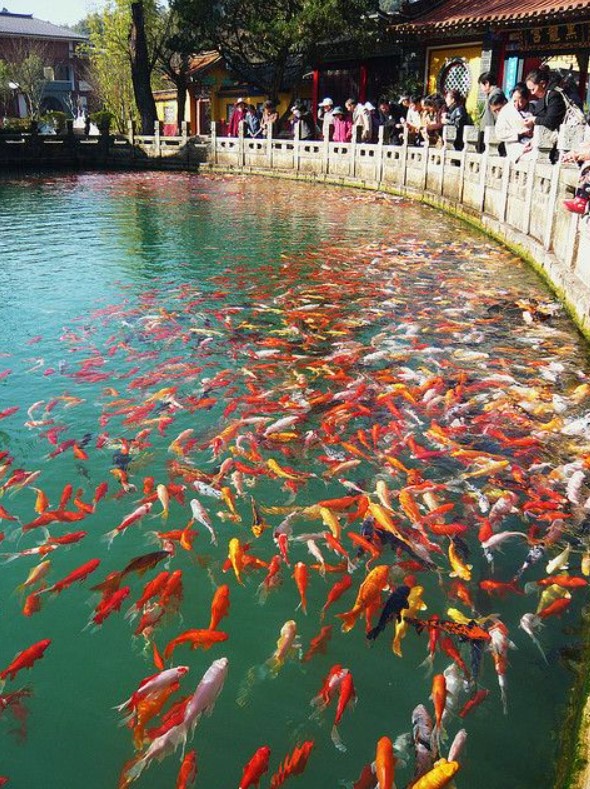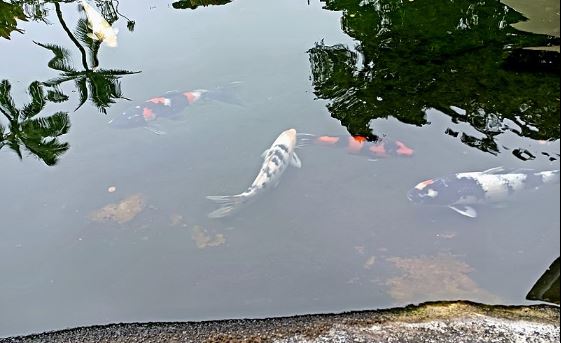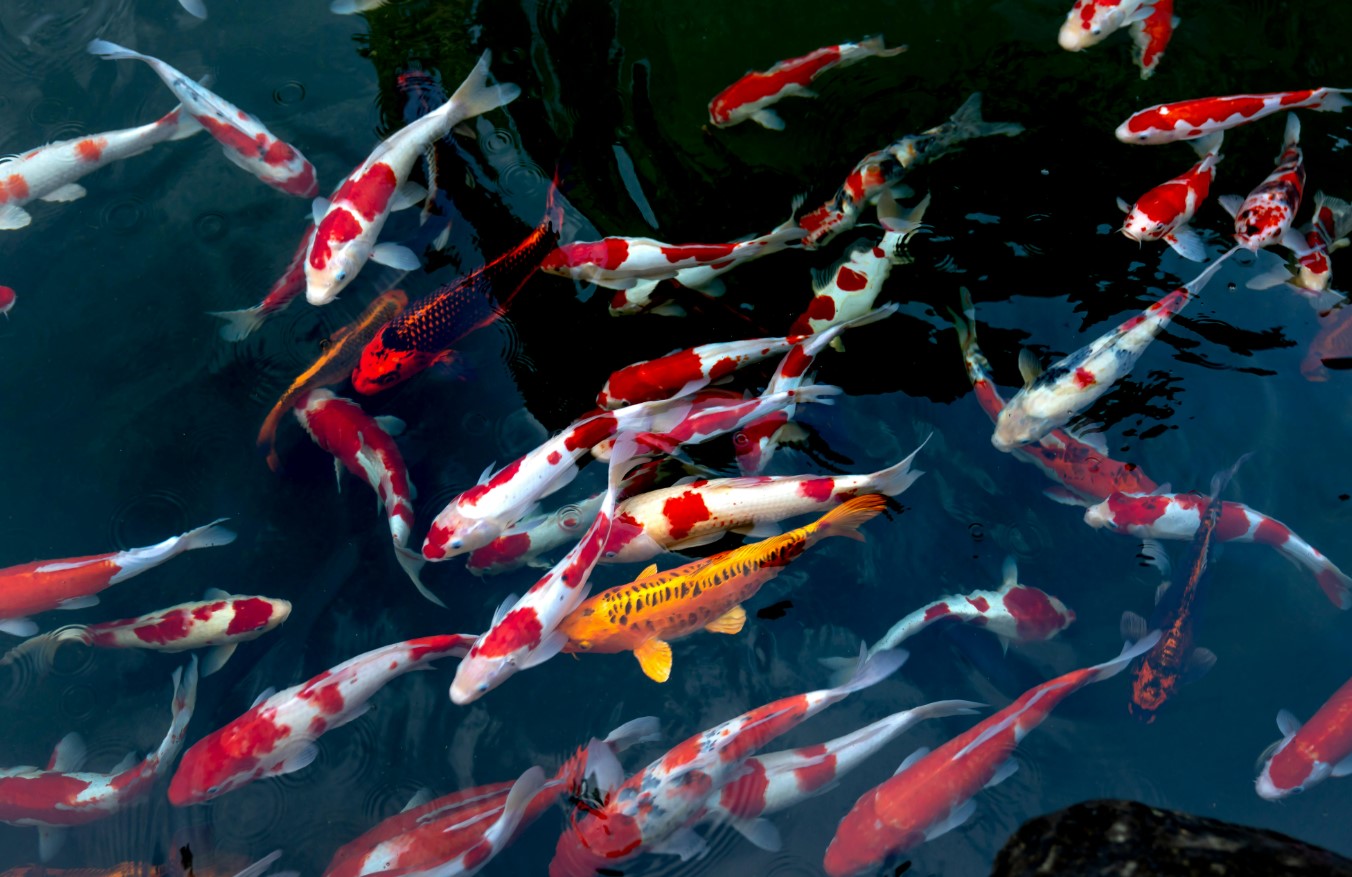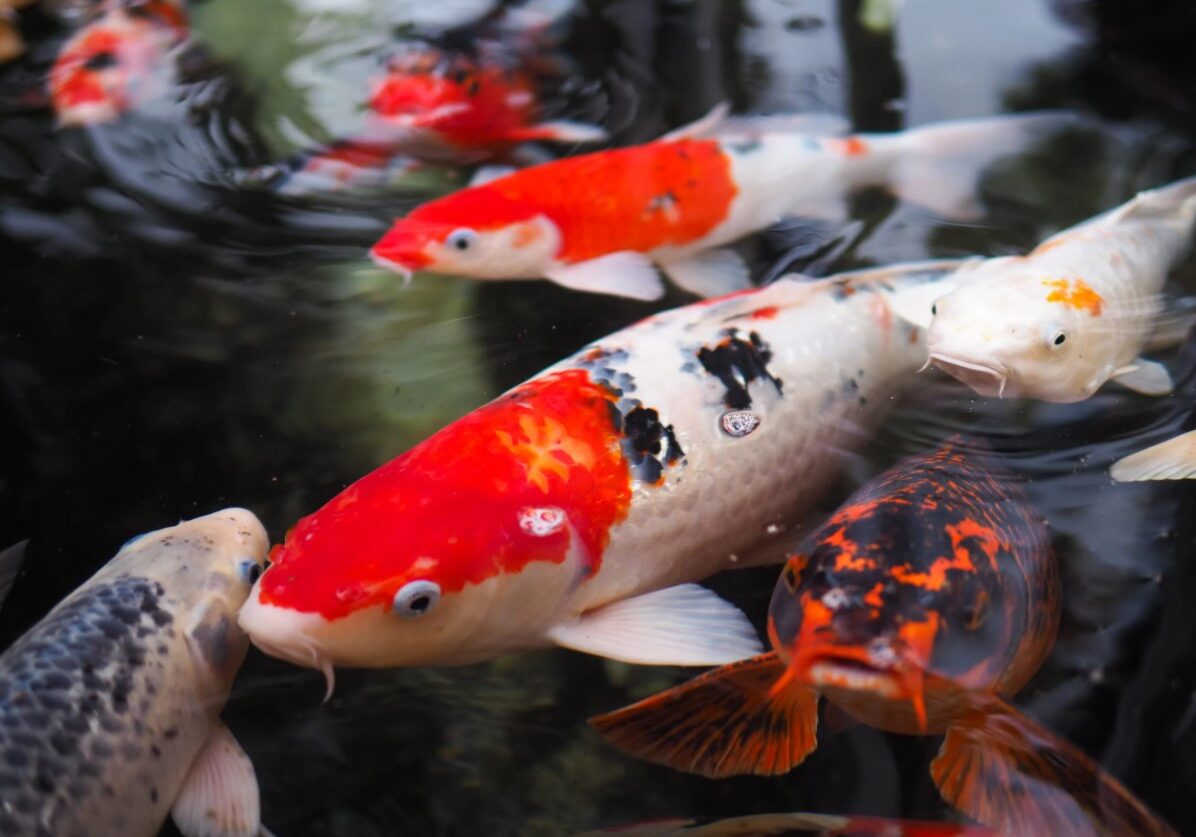
Let's learn more about Koi fish!
Koi (鯉, Japanese: [koꜜi], literally "carp"), or more specifically nishikigoi (錦鯉, Japanese: [ɲiɕi̥kiꜜɡoi], literally "brocaded carp"), are colored varieties of carp (Cyprinus sp.) that are kept for decorative purposes in outdoor koi ponds or water gardens.
Koi is an informal name for the colored variants of carp kept for ornamental purposes. There are many varieties of ornamental koi, originating from breeding that began in Niigata, Japan in the early 19th century.
Several varieties are recognized by Japanese breeders and owners, distinguished by coloration, patterning, and scalation. Some of the major colors are white, black, red, orange, yellow, blue, brown and cream, besides metallic shades like gold and silver-white ('platinum') scales. The most popular category of koi is the Gosanke, which is made up of the Kōhaku, Taishō Sanshoku and Shōwa Sanshoku varieties.
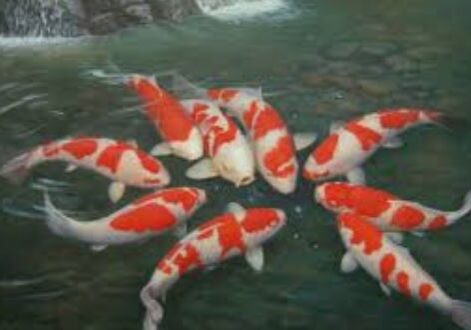
Discover the
Prehistory of the Koi fish
In Japan, Miocene fossils of the carp family (Cyprinidae) have been excavated from Iki Island, Nagasaki Prefecture. Furthermore, numerous carp pharyngeal teeth have been excavated from Jomon and Yayoi period sites. For example, pharyngeal teeth of the extinct species Jōmon Koi (Cyprinus sp.) in addition to the modern species of carp (Cyprinus carpio or Cyprinus rubrofuscus) have been excavated from the Akanoi Bay lakebed site (赤野井湾湖底遺跡) in Lake Biwa at the end of the Early Jomon Period (11,500 – 7,000 years ago).[5] In addition, pharyngeal teeth of all six subfamilies of the Cyprinidae family living in Japan today, including carp (Cyprinus), have been found at the Awazu lakebed site (粟津湖底遺跡) dating from the Middle Jomon Period (5500 – 4400 years ago).
There are differences in the length distribution of carp excavated from Jomon and Yayoi sites, as estimated from the size of their pharyngeal teeth. Specifically, not only adult carp but also juvenile carp (less than 150 mm in length) have been found at the Yayoi site. This difference is thought to be because the Jomon only collected carp from lakes and rivers, while the Yayoi cultivated primitive carp along with the spread of rice paddies.
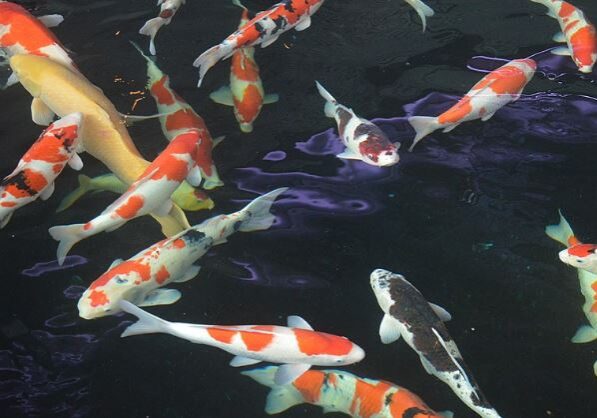
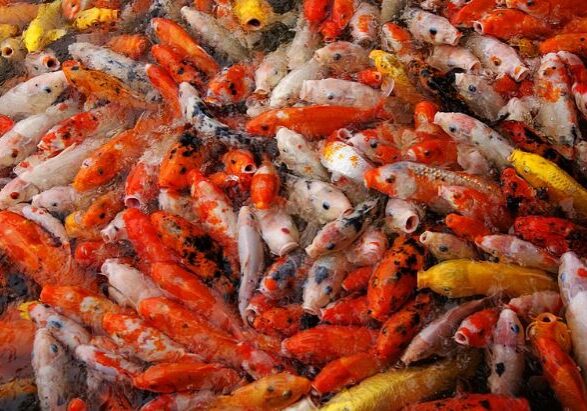
It was previously thought that all Japanese carp were introduced from China in prehistoric times. However, recent analysis of mitochondrial DNA revealed a significant evolutionary divergence (phylogenetic split) within common carp Cyprinus carpio between the native wild form found in Lake Biwa and the Eurasian wild form, along with domesticated varieties. This supports the idea of the ancient origin of the native Japanese form (Cyprinus sp.), as well as the East Asian ancient lineage of wild common carp (C. carpio), previously proposed on the basis of fossil data. However, it is unknown when the carp from the continent was introduced to Japan. In addition, a possible multiple origin of koi carp was indicated by the polyphyletic distribution of five mtDNA haplotypes of koi carp within the ‘Eurasian’ clade. Moreover, the oldest record of the introduction of non-native fish in Japan is that of goldfish from China (1502 or 1602), and there is no record of carp (including colored carp) until the introduction of the mirror carp, called Doitsugoi (German carp), in 1904.
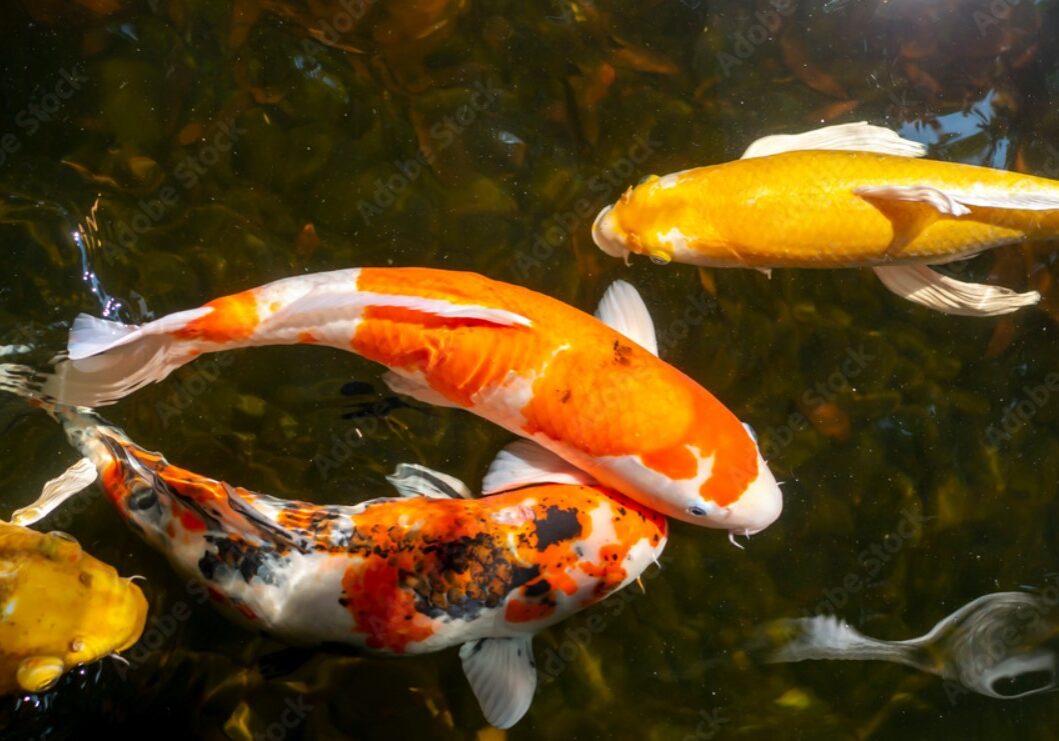
Discover the
Japan's oldest drug dictionary, Fukane Sukehito's Honzō Wamyō (本草和名, 918) mentions red carp (赤鯉), blue carp (青鯉), black carp (黒鯉), white carp (白鯉), and yellow carp (黄鯉) as Japanese names corresponding to the above Chinese names, suggesting that carp of these colors existed in China and Japan in those days. In addition, Hitomi Hitsudai's drug dictionary Honchō Shokkan (本朝食鑑, Japanese Medicine Encyclopedia, 1697) states that red, yellow, and white carp of the three colors were in Japan at that time.
However, it is believed that these single-colored carp were not a variety created by artificial selection, as is the case with today's koi, but rather a mutation-induced color change. In ancient times, carp was farmed primarily for food. Mutational color variation in carp is relatively common in nature, but is not suitable for development alongside farming for food in poor rural communities; color inheritance is unstable and selection to maintain color variation is costly. For example, in current-day farming of koi as ornamental fish, the percentage of superior colored fish to the number of spawn is less than 1%.
The Amur carp (Cyprinus rubrofuscus) is a member of the cyprinid family species complex native to East Asia. Amur carp were previously identified as a subspecies of the common carp (as C. c. haematopterus), but recent authorities treat it as a separate species under the name C. rubrofuscus. Amur carp have been aquacultured as a food fish at least as long ago as the fifth century BC in China.
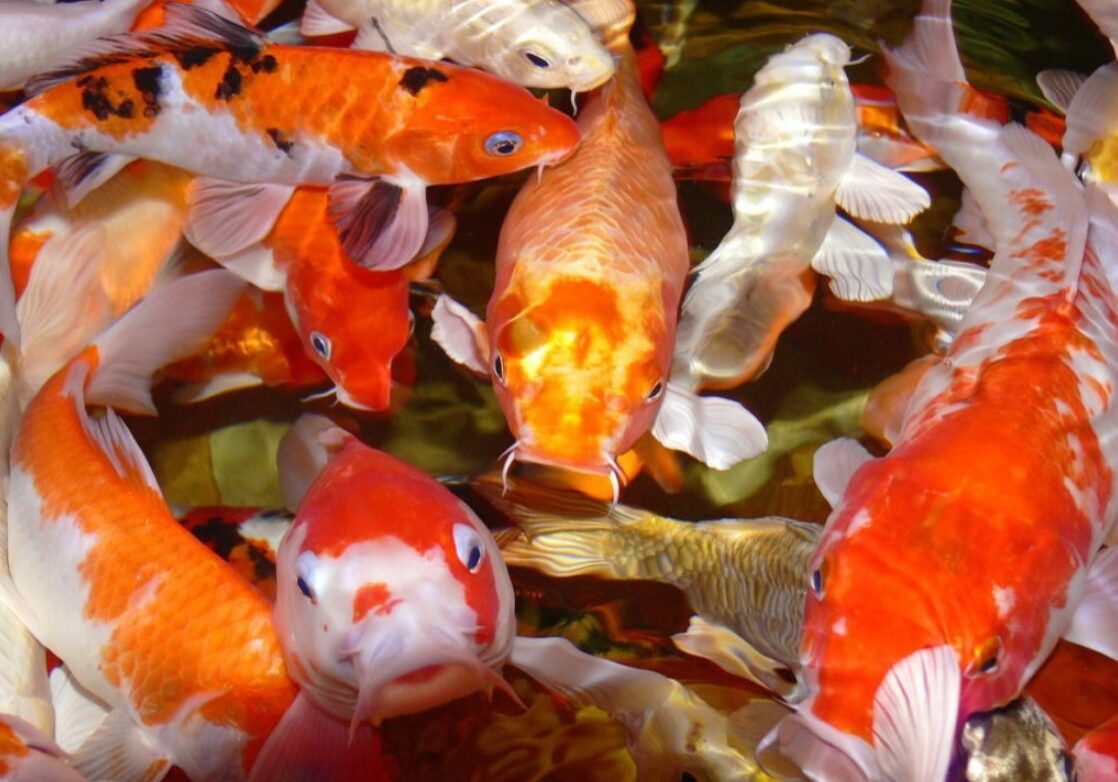
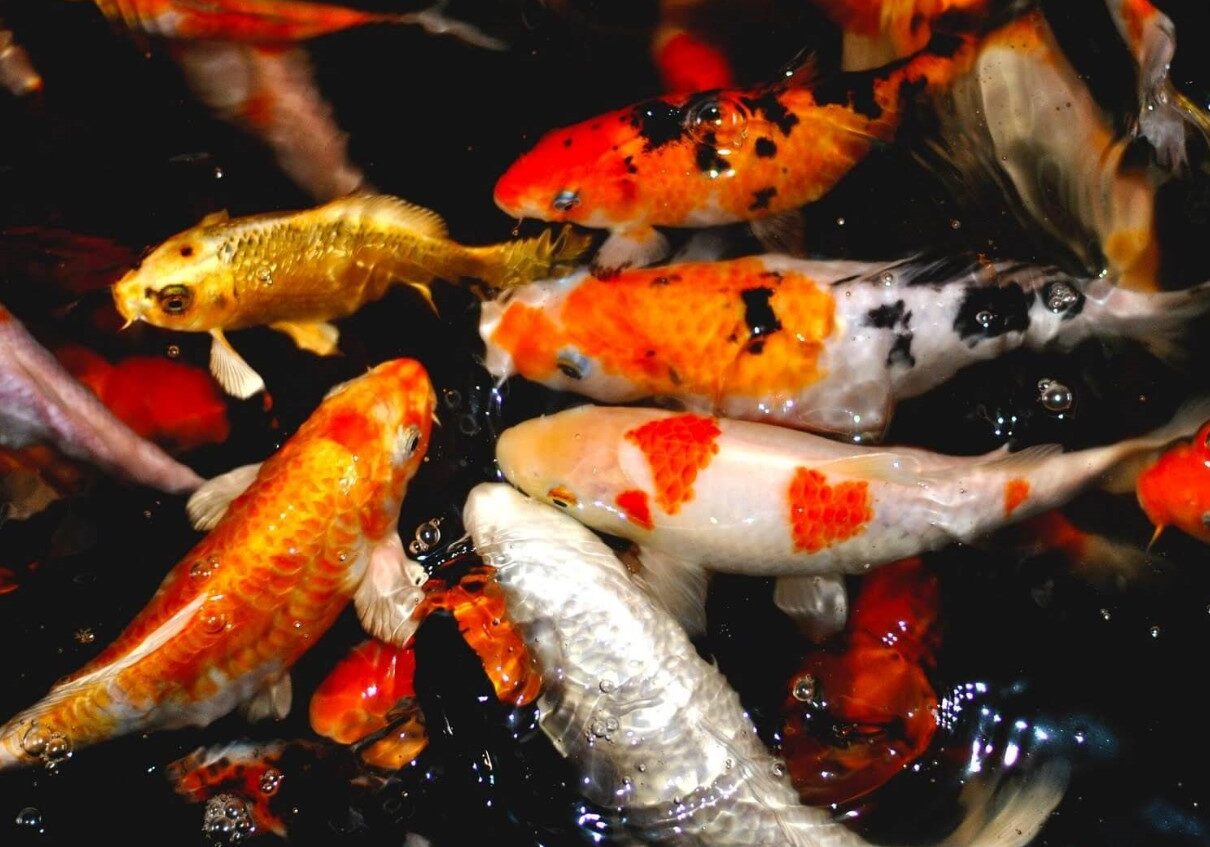
Koi fish in the modern period
The systematic breeding of ornamental Amur carp began in the 1820s in an area known as "Nijūmuragō" (二十村郷, lit. 'twenty villages') which spans Ojiya and Yamakoshi in Niigata Prefecture (located on the northeastern coast of Honshu) in Japan. In Niigata Prefecture, Amur carp were farmed for food in Musubu Shinden, Kanbara County (present Akiba Ward, Niigata City) from the end of the Genna era (1615–1624).
In the Nijūmuragō area, carp were also farmed in terraced ponds near terraced rice paddies by 1781 at the latest, but the ponds ran dry due to a severe drought that occurred around that time, and the carp escaped the disaster by taking refuge in ponds on the grounds of Senryu Shrine in Higashiyama Village and Juni Shrine in Higashitakezawa Village.
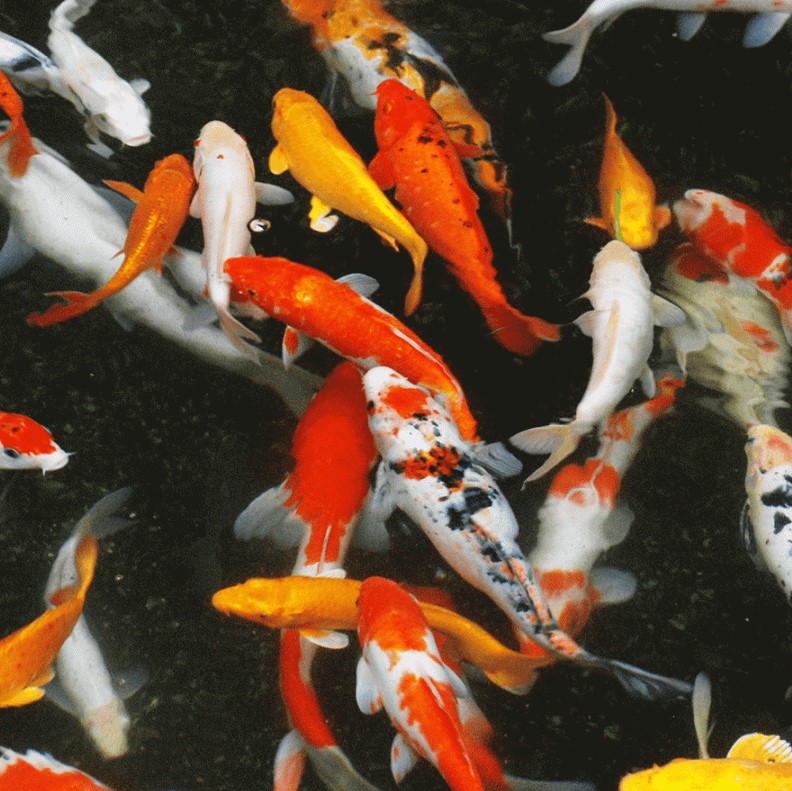
Around 1875, colored koi became popular and the number of breeders increased, and some expensive koi were produced, but Niigata Prefecture banned the aquaculture of ornamental koi because it was considered a speculative business, and the business suffered a major blow for a time. However, the ban was lifted soon after, thanks to the petition of the villagers. At that time, colored koi included Kōhaku, Asagi, Ki Utsuri, etc. From this original handful of koi varieties, all other Nishikigoi varieties were bred, with the exception of the Ogon variety (single-colored, metallic koi), which was developed relatively recently.
The name Nishikigoi (brocaded carp) did not exist until the 1910s. Before that time, Nishikigoi were called Madaragoi (斑鯉, lit. 'spotted carp'), Kawarigoi (変鯉, lit. 'variant carp'), Irogoi (色鯉, lit. 'colored carp'), Moyōgoi (模様鯉, lit. 'patterned carp'), and so on.
A geographical book on Suruga Province (present-day Shizuoka Prefecture), Abe Masanobu's Sunkoku Zasshi (1843), mentions that in addition to Asagi, purple, red, and white carp, there are "spotted carp (also known as Bekko carp)." This probably refers to two- or three-colored carp caused by mutation, and is a valuable record of Nishikigoi of the Edo period (1603 – 1868).
Illustration of a three-colored carp in Ritsurin Garden, 1900. This is the oldest illustration of koi. It has the kanji characters for asagi on its back and red on its belly.
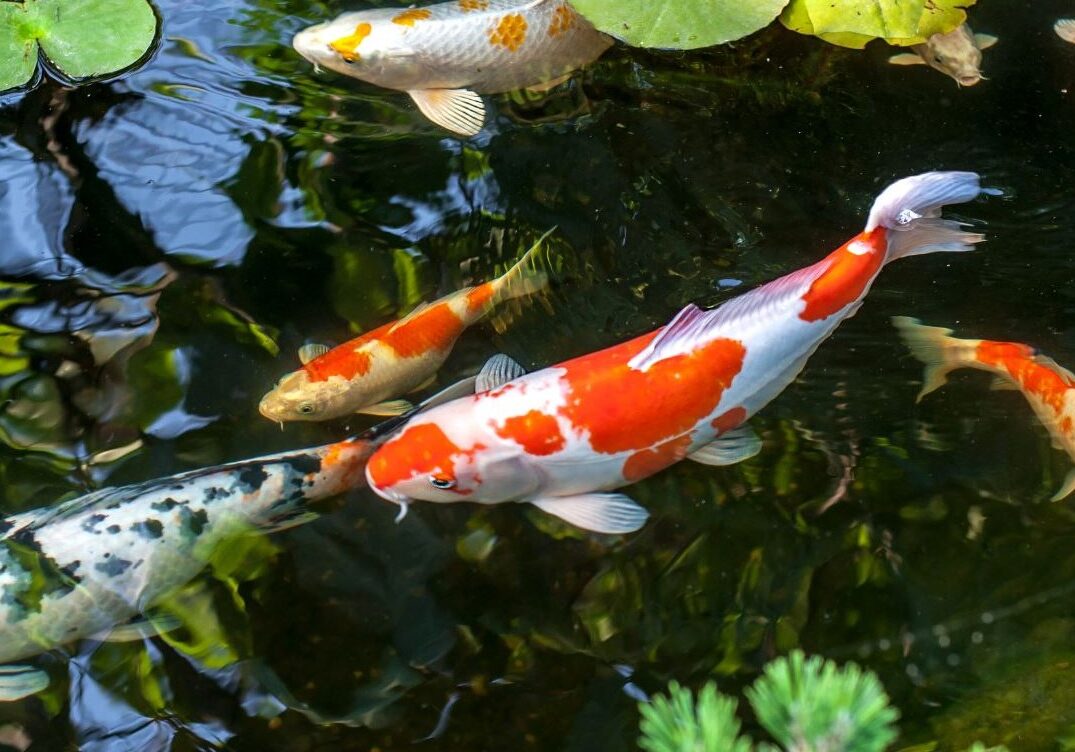
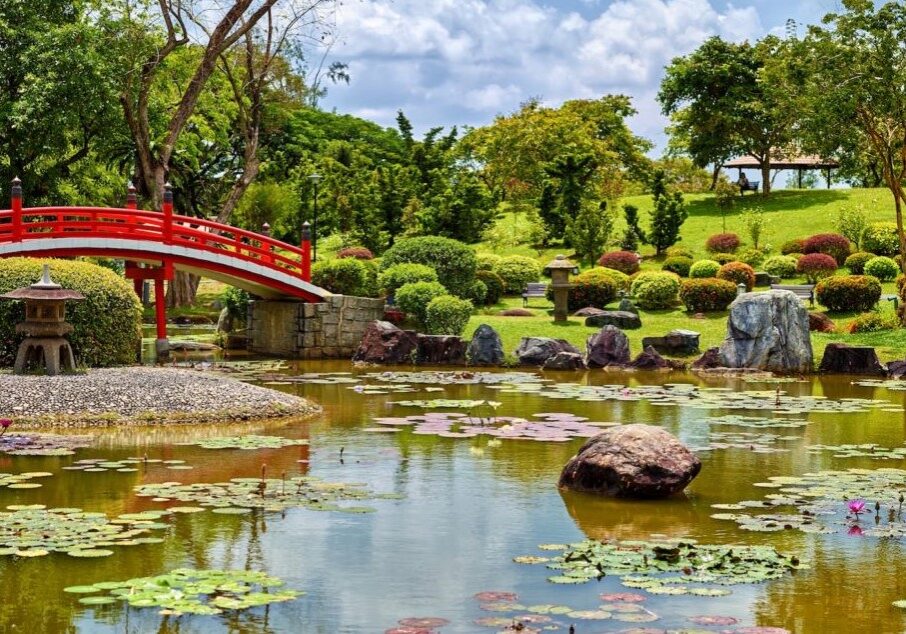
In 1900, there was a three-colored carp in Ritsurin Garden in Takamatsu, Kagawa Prefecture, and the price was over 1,000 yen per fish, which was a high price for that time. The three-colored carp had a red belly and asagi (light blue) back with black spots, and is thought to have been a mutation similar to today's Asagi koi.
The magazine "Shonen" (1910) introduced Nishikigoi under the name of Madaragoi (spotted carp) or Kawarigoi (variant carp), and said that even skilled fish breeders did not know how they could produce Nishikigoi, but only waited for them to be produced by chance. The price of Nishikigoi at a fish show in Fukagawa, Tokyo, was 100 to 150 yen per fish, which was "extremely expensive" at the time. Therefore, even at that time, mutant Nishikigoi were known to some fish breeders and hobbyists in Tokyo, but artificial breeds such as Nijūmuragō's Nishikigoi were still unknown to the general public.
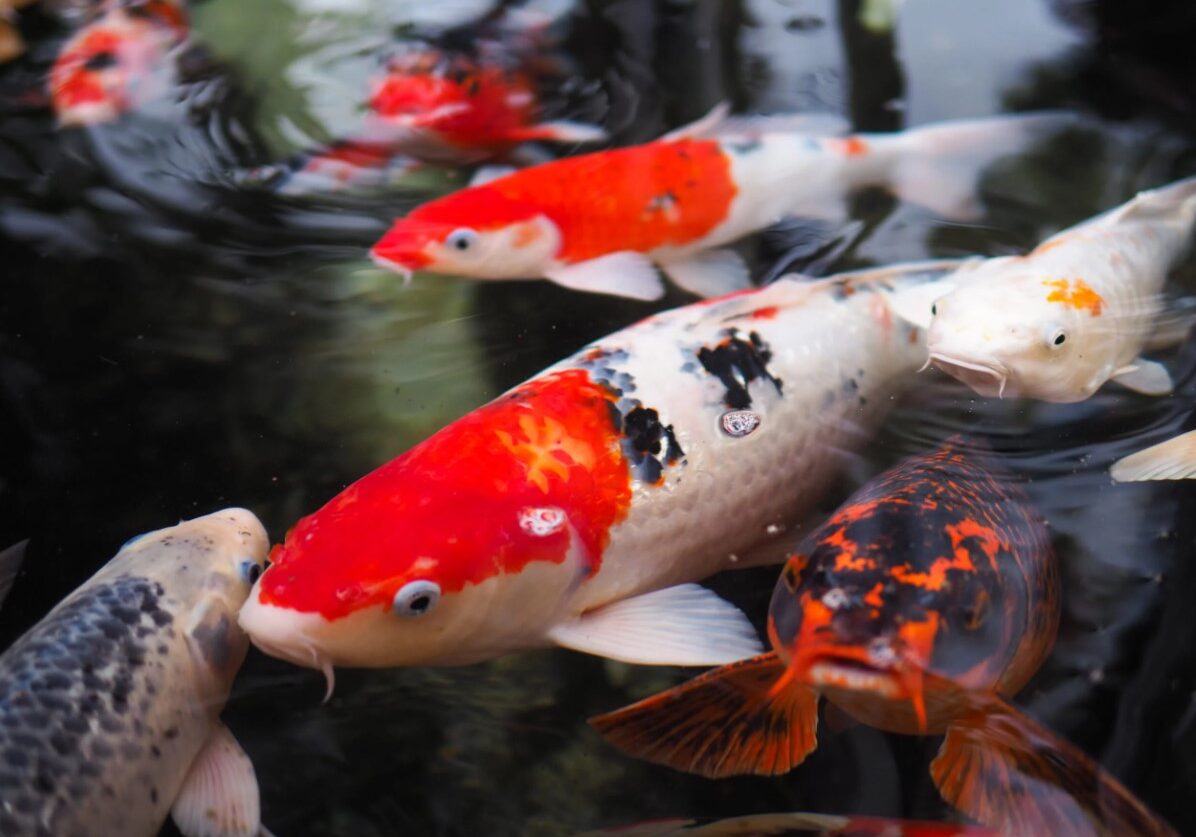
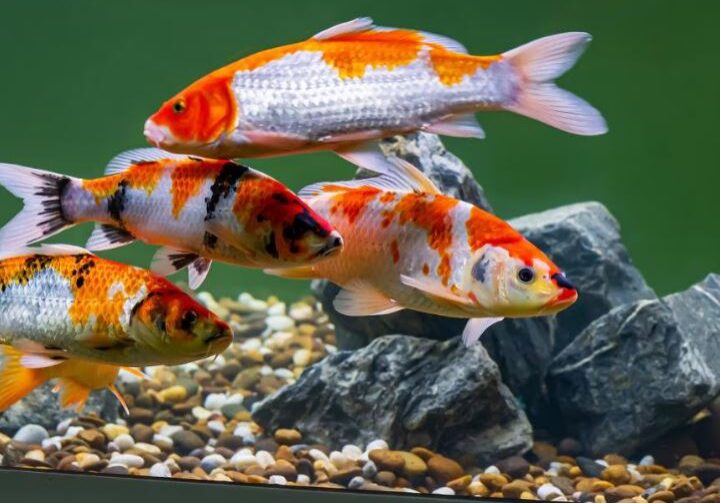
In 1914, when the Tokyo Taishō Exposition was held, the "Koi Exhibit Association" was formed mainly by koi breeders in Higashiyama and Takezawa villages, and koi were exhibited. At the time, they were still called "colored carp" or "patterned carp," and they were described as "the first of their kind ever seen in the Tokyo area." And the koi received much attention, winning a silver medal. After the exposition closed, they presented eight koi to the Crown Prince (Emperor Showa). This exhibition triggered an expansion of sales channels, and the market value of koi soared.
In 1917, the Taishō Sanshoku (by Eizaburo Hoshino) was fixed as a breed. The name Nishikigoi is said to have been given by Kei Abe, who was the chief fisheries officer of the Niigata Prefectural Government in the Taisho era (1912–1926), after he admired the Taishō Sanshoku when he first saw it. In 1917, the fixation of Kōhaku (by Kunizo Hiroi), which had first been produced in the 1880s, was also assured.
Apart from the koi of Niigata Prefecture's Nijūmuragō area, there is a variety called Shūsui (秋翠), which was created by Tokyo-based goldfish breeder Kichigoro Akiyama in 1906 by crossing a female leather carp imported from Germany with a male Japanese Asagi or spotted carp. The leather carp is a low scaled variety bred in 1782 in Austria, and was sent to Japan from Munich, Germany in 1904, along with the mirror carp, which also has few scales. In Japan, these two varieties are called Doitsugoi (German carp), and Shūsui and its lineage are also called Doitsu or Doitsugoi in koi.
In 1927, Shōwa Sanshoku (by Shigekichi Hoshino) was fixed as a breed, and in 1939, koi were exhibited at the Japanese pavilion at the Golden Gate International Exposition held in San Francisco.
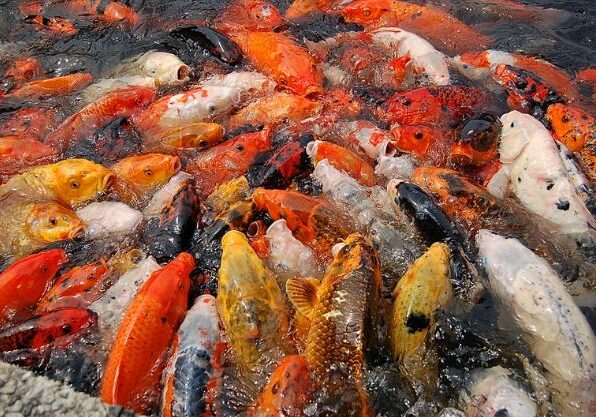
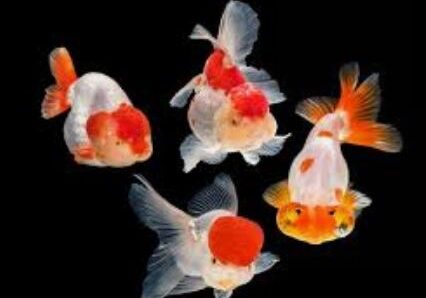
The question is
Are Koi fish Gold fish?
Koi have prominent barbels on the lip that are not visible in goldfish.
Goldfish (Carassius auratus) were developed in China more than a thousand years ago by selectively breeding colored varieties; by the Song dynasty (960–1279), yellow, orange, white, and red-and-white colorations had been developed. Goldfish were introduced to Japan in the 16th century and to Europe in the 17th century. On the other hand, most ornamental koi breeds currently distributed worldwide originate from Amur carp (Cyprinus rubrofuscus) bred in Japan in the first half of the 19th century. Koi are domesticated Amur carp that are selected or culled for color; they are not a different species, and will revert to the original coloration within a few generations if allowed to breed freely.
Some goldfish varieties, such as the common goldfish, comet goldfish, and shubunkin, have body shapes and coloration that are similar to koi, and can be difficult to tell apart from koi when immature. Goldfish and koi can interbreed; however, as they were developed from different species of carp, their offspring are sterile.
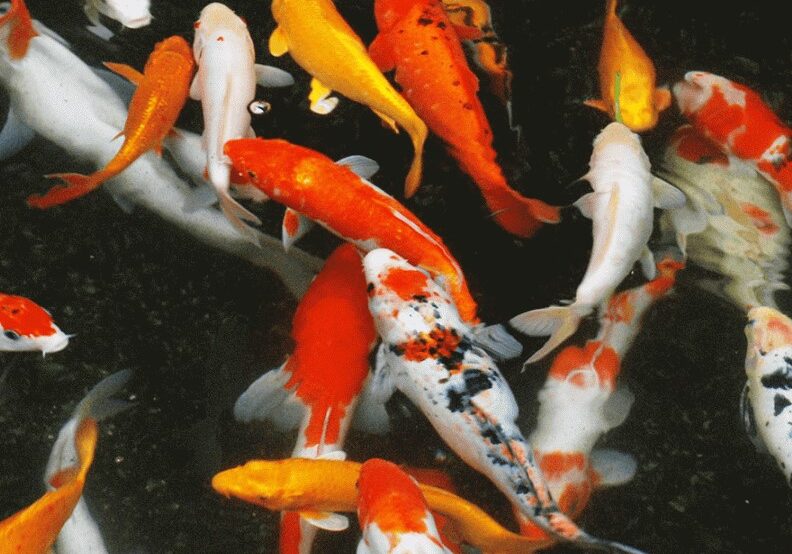
The bright colors of koi put them at a severe disadvantage against predators; a white-skinned Kōhaku is highly noticeable against the dark green of a pond. Herons, kingfishers, otters, raccoons, skunk, mink, cats, foxes, and badgers are all capable of spotting out koi and eating them. A well-designed outdoor pond has areas too deep for herons to stand, overhangs high enough above the water that mammals cannot reach in, and shade trees overhead to block the view of aerial passers-by. It may prove necessary to string nets or wires above the surface. A pond usually includes a pump and a filtration system to keep the water clear.
Koi are an omnivorous fish. They eat a wide variety of foods, including peas, lettuce, and watermelon. Koi food is designed not only to be nutritionally balanced, but also to float so as to encourage them to come to the surface. When they are eating, koi can be checked for parasites and ulcers. Naturally, koi are bottom feeders with a mouth configuration adapted for that. Some koi have a tendency to eat mostly from the bottom, so food producers create a mixed sinking and floating combination food. Koi recognize the persons feeding them and gather around them at feeding times. They can be trained to take food from one's hand.[53] In the winter, their digestive systems slow nearly to a halt, and they eat very little, perhaps no more than nibbles of algae from the bottom. Feeding is not recommended when the water temperature drops below 10 °C (50 °F). Care should be taken by hobbyists that proper oxygenation, pH stabilization, and off-gassing occur over the winter in small ponds. Their appetites do not come back until the water becomes warm in the spring.
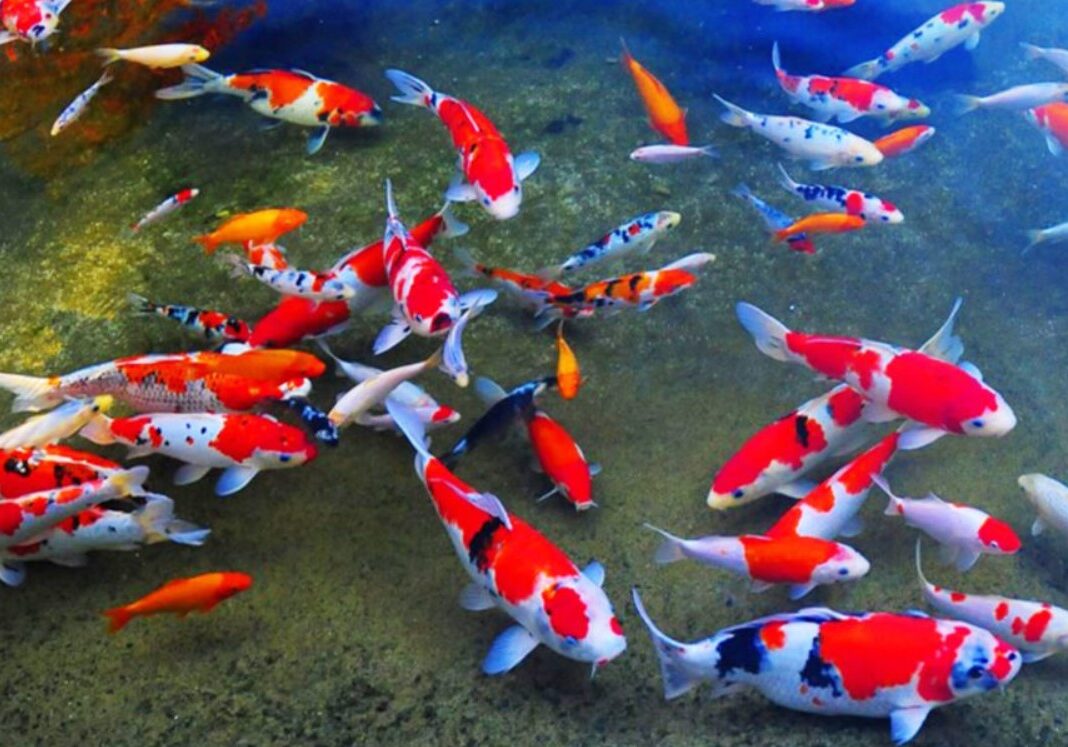
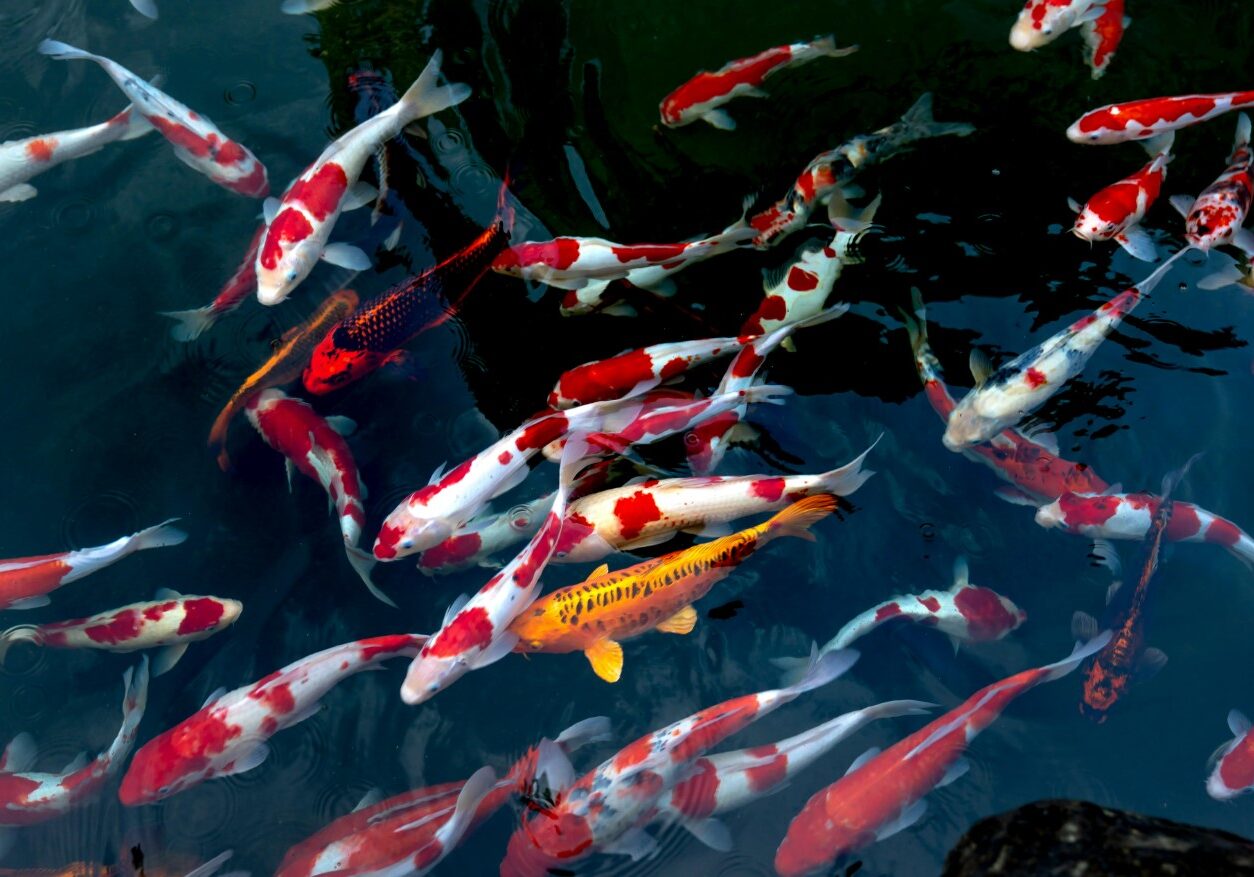
Koi have been reported to achieve ages of 100–200 years. One famous scarlet koi named "Hanako" was owned by several individuals, the last of whom was Komei Koshihara. In July 1974, a study of the growth rings of one of the koi's scales reported that Hanako was 226 years old. Some sources give an accepted age for the species at little more than 50 years.
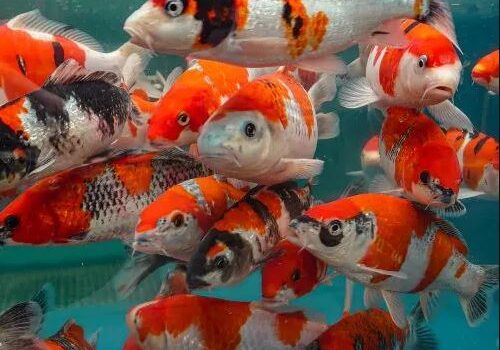
Koi greatly increase the turbidity of the water because they are constantly stirring up the substrate. This makes waterways unattractive, reduces the abundance of aquatic plants, and can render the water unsuitable for swimming or drinking, even by livestock. In some countries, koi have caused so much damage to waterways that vast amounts of money and effort have been spent trying to eradicate them, largely unsuccessfully.
In many areas of North America, koi are introduced into the artificial "water hazards" and ponds on golf courses to keep water-borne insect larvae under control through predation.
What's the meaning of Koi fish?
Koi has represented a beautiful meaning since ancient times and is deeply loved by people. Carp is often associated with good things such as passing the imperial examination, getting rich, and getting promoted. There is a legend of "carp jumping over the dragon gate" among the Chinese people. In addition, "carp" is the same as "profit" and "fish" is the same as "surplus", which means good luck and surplus every year. Therefore, the image of carp often appears in New Year pictures, paper-cuts, embroidered fabrics, etc., representing people's yearning for a rich and happy life. This is a totem belief rooted in traditional culture.
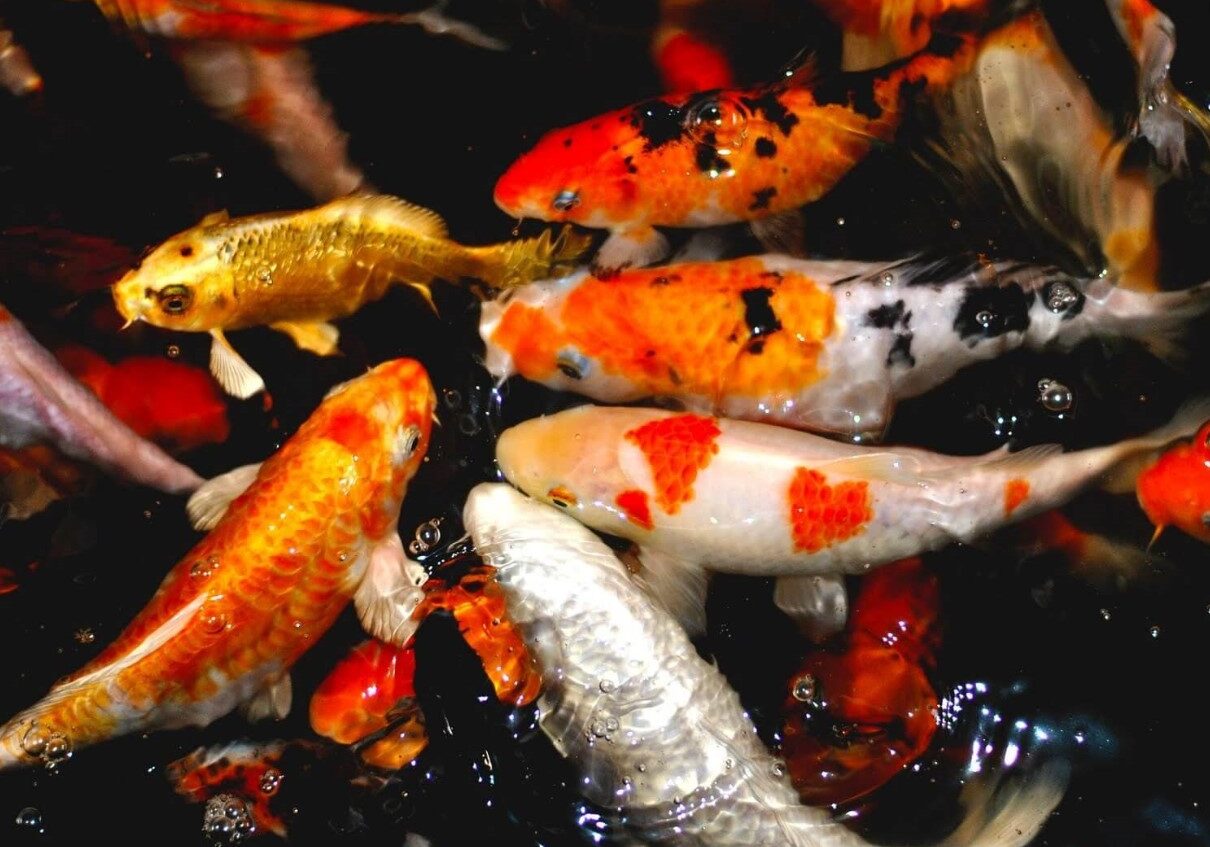
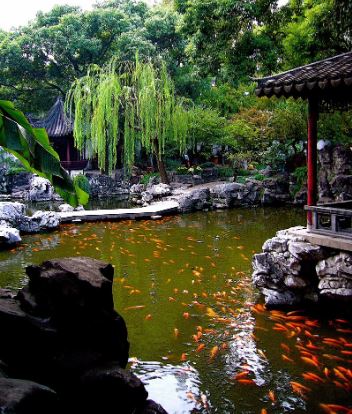
Koi in chinese culture
In Chinese culture, the koi represents fame, family harmony, and wealth. It is a feng shui favorite, symbolizing abundance as well as perseverance and strength, and has a mythical potential to transform into a dragon. Since the late 20th century, the keeping of koi in outdoor water gardens has become popular among the more affluent Chinese. Koi ponds are found in Chinese communities around the world, and the number of people who keep koi imported from Niigata, has been increasing. In addition, there are increasing numbers of Japanese koi bred in China that are sold domestically and exported to foreign countries.
Koi are also popular in many countries in the equatorial region, where outdoor water gardens are popular. In Sri Lanka, interior courtyards most often have one or several fish ponds dedicated to koi.
